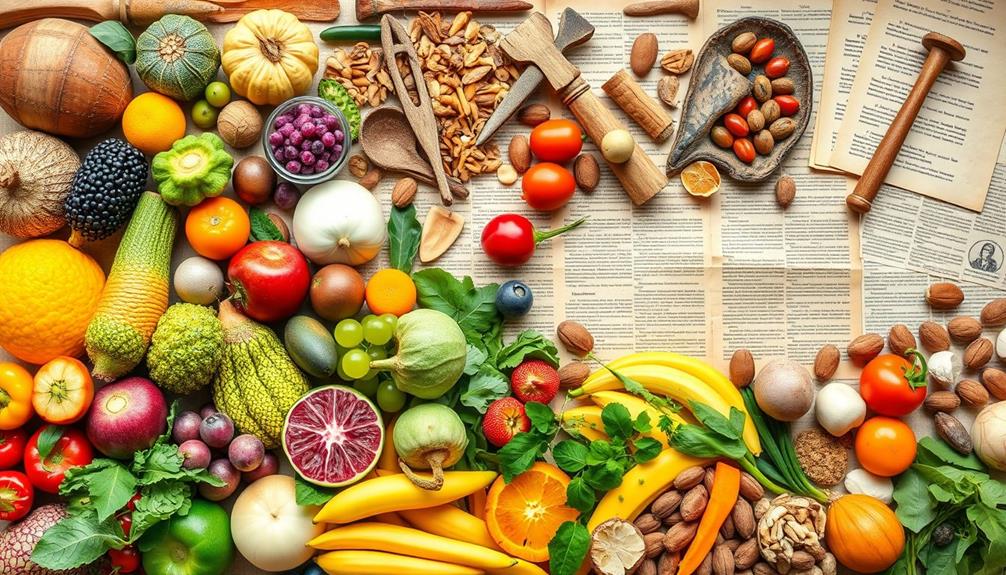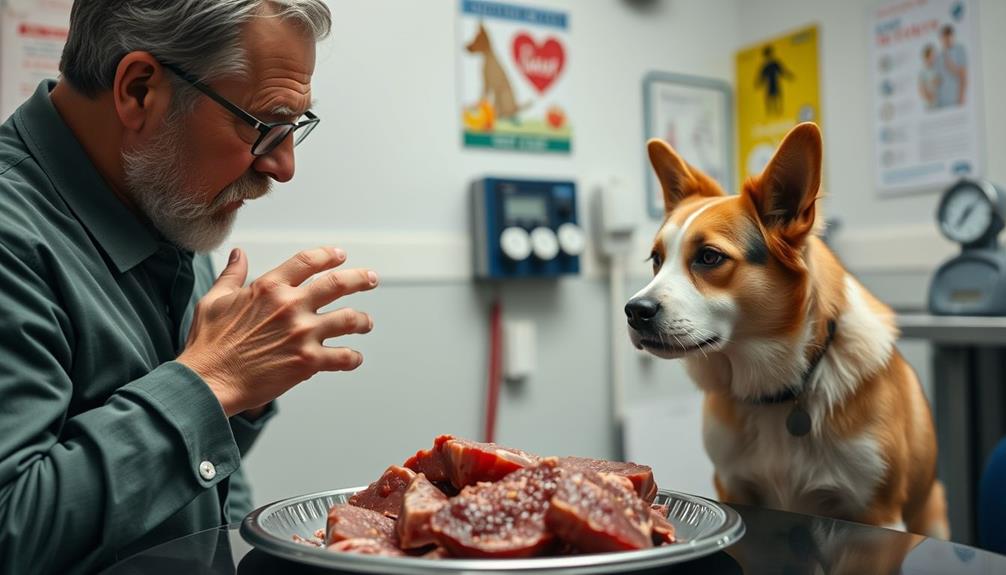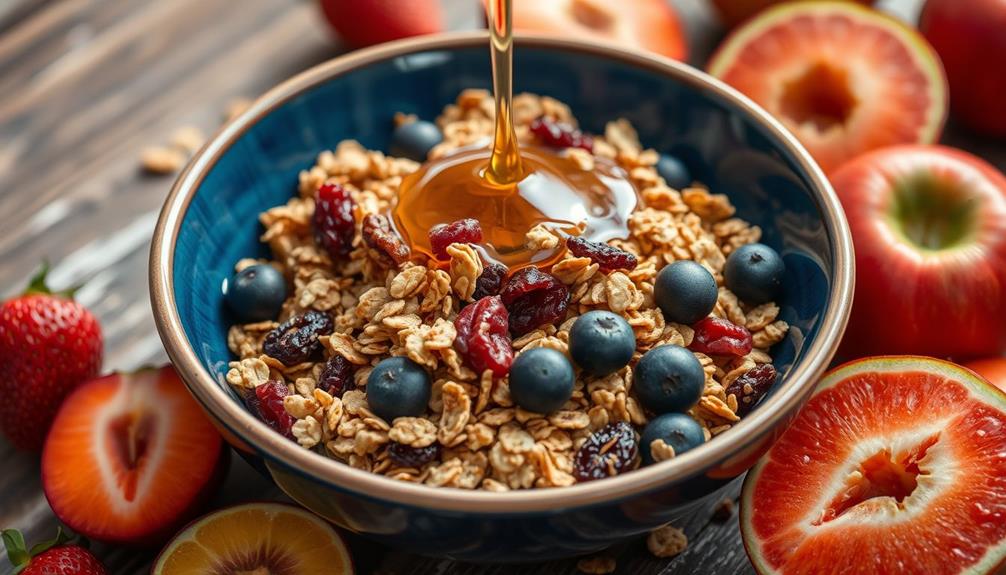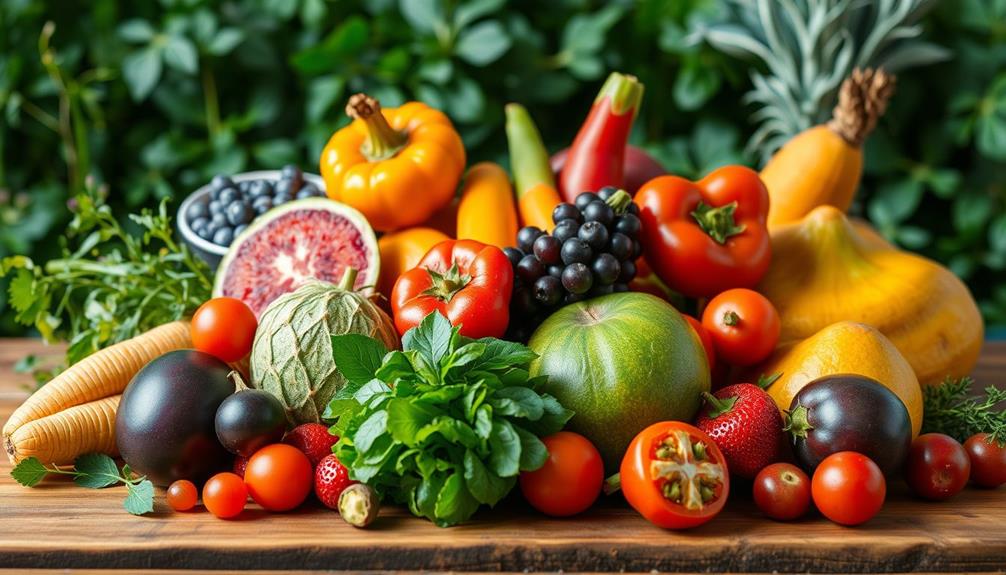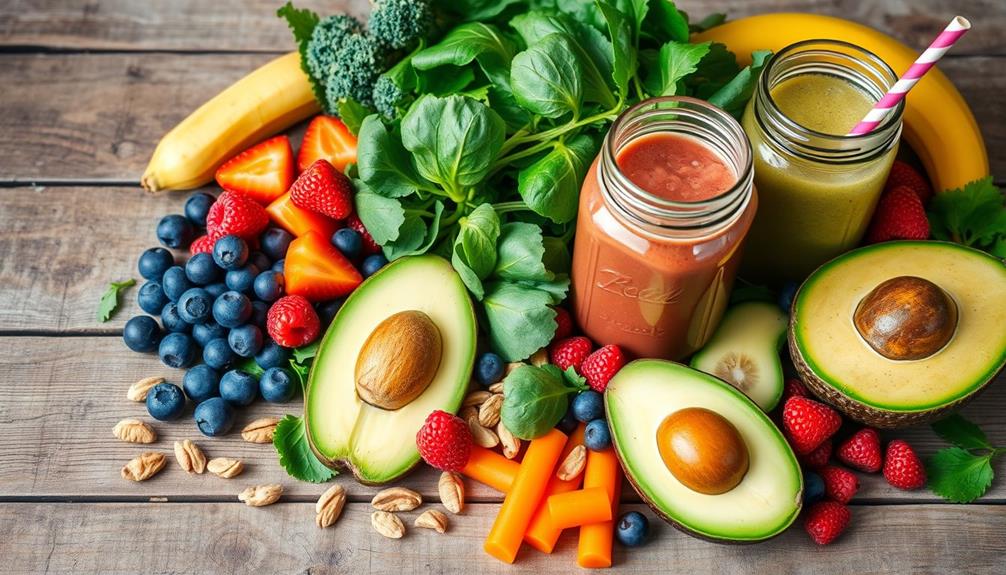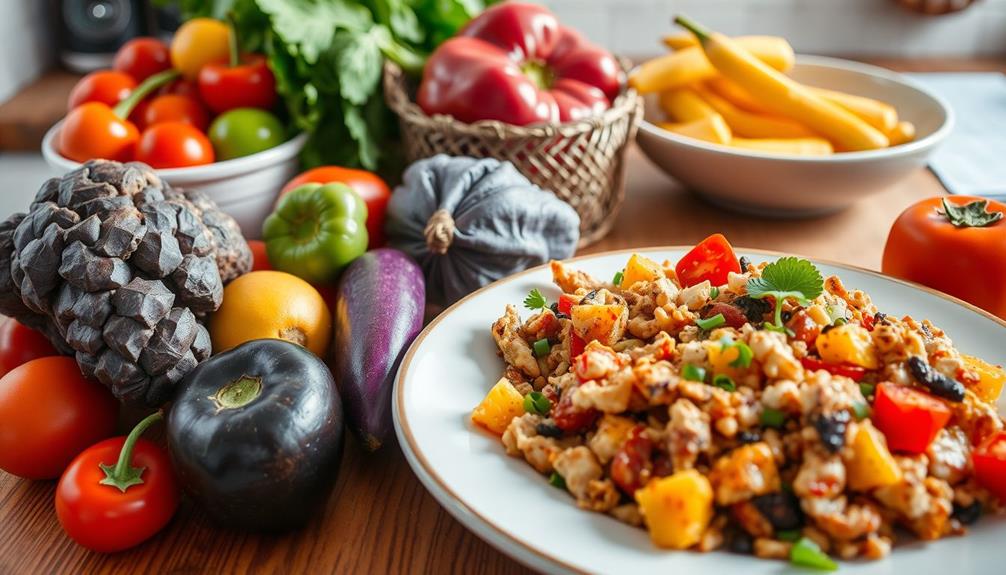The history of the raw food diet dates back to the 1800s, beginning with Swiss physician Maximilian Oskar Bircher-Benner, who highlighted the benefits of uncooked fruits and vegetables. By 1923, the term "Raw Foodism" emerged, focusing on unheated foods to retain nutrients. Influential figures like Eugene and Mrs. Christian, Ann Wigmore, and Norman W. Walker further popularized this lifestyle, tying it to health restoration and spiritual practices. As you explore this diet, you'll uncover its nutritional benefits, potential risks, and modern-day interpretations that emphasize both health and sustainability. There's much more to discover about its evolution. With the rise of the internet and social media, the raw food diet has gained even more attention in recent years. People are sharing their success stories, recipes, and tips for incorporating more raw food examples into their daily meals. This has led to a greater understanding of the variety and versatility of the raw food diet, as well as the potential challenges of maintaining it in a modern, fast-paced world. Despite these challenges, the raw food movement continues to evolve and inspire people to explore the benefits of eating more unprocessed, nutrient-dense foods.
Key Takeaways
- The raw food diet originated in the 1800s, promoted by Swiss physician Maximilian Oskar Bircher-Benner for its health benefits.
- The term "Raw Foodism" was coined in 1923, highlighting the emphasis on unheated foods to preserve nutrients.
- Influential advocates, including Eugene and Mrs. Christian, popularized raw food in the early 20th century through their book on uncooked foods.
- The 1960s counterculture embraced raw foods as part of a natural lifestyle, influenced by figures like Ann Wigmore and Norman W. Walker.
- Historical dietary practices show uncooked food consumption linked to asceticism, with hermits and monks using it for spiritual discipline.
Origins of Raw Food Diet
Tracing the roots of the raw food diet, you'll find its origins in the 1800s, primarily through the work of Swiss physician Maximilian Oskar Bircher-Benner. He championed the health benefits of consuming uncooked and unprocessed fruits and vegetables, particularly raw apples, believing they could restore energy.
In fact, many proponents of natural health, like those who advocate for essential oils for wellness, emphasize the importance of unprocessed foods in enhancing overall health.
In 1904, Mr. and Mrs. Eugene Christian further popularized this lifestyle with their publication "Uncooked Foods and How to Use Them," arguing that embracing raw food could liberate women from the burdens of cooking while promoting better health.
The term "Raw Foodism" emerged in a 1923 publication, defining it as food that's not subjected to heat, emphasizing the preservation of freshness and nutrients. This philosophy aligns with historical practices rooted in ascetic traditions among hermits and monks, who valued the health benefits of minimal food processing. Their commitment to raw foods greatly influenced the modern raw food movement.
Bircher-Benner also established a sanatorium in Switzerland, where he introduced patients to raw food diets as a revolutionary approach to health and wellness. His pioneering work laid the groundwork for what would become a popular dietary choice for many seeking a natural lifestyle today.
Key Figures and Advocates

Key figures and advocates have played a crucial role in shaping the raw food diet's philosophy and popularity throughout history. Maximilian Bircher-Benner, a Swiss physician, was instrumental in the early 20th century, promoting raw foods for their health benefits through his Zurich sanatorium. Eugene and Mrs. Christian also made significant contributions with their 1904 book, "Uncooked Foods and How to Use Them," which advocated for raw food consumption to restore health.
Another notable advocate, Ann Wigmore, emphasized the healing properties of wheatgrass and living foods during the 1960s and 1970s. Similarly, Norman W. Walker, a passionate supporter of raw diets, published numerous works highlighting the benefits of uncooked foods in the mid-20th century.
Here's a table highlighting these key figures and their contributions:
| Advocate | Contribution | Focus Area |
|---|---|---|
| Maximilian Bircher-Benner | Promoted raw foods for health benefits | Raw food movement |
| Eugene and Mrs. Christian | Authored "Uncooked Foods and How to Use Them" | Health restoration |
| Ann Wigmore | Advocated for wheatgrass and living foods | Healing properties |
Nutritional Insights and Guidelines
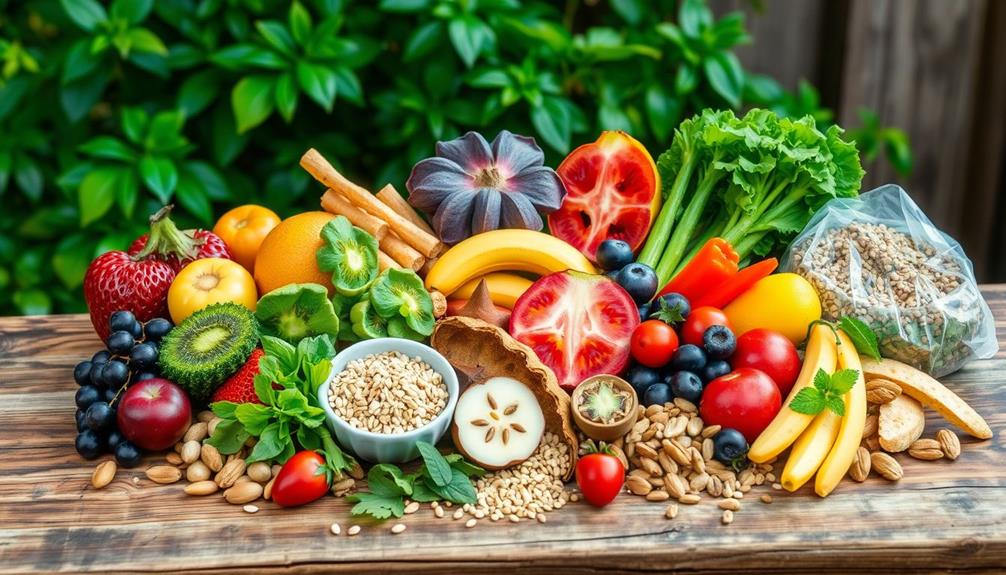
When you explore the raw food diet, it's crucial to take into account nutrient density, as well as food preparation methods that keep those nutrients intact.
You might also find that some nutrients require careful planning or supplementation to meet your needs.
Balancing raw and cooked foods can help you achieve ideal health benefits while ensuring you're not missing out on essential nutrients.
Nutrient Density Considerations
The raw food diet focuses on maximizing nutrient density by emphasizing whole, unprocessed foods, particularly fresh fruits and vegetables. By consuming these foods, you retain maximum vitamins, minerals, and enzymes fundamental for your health.
However, it's important to recognize that cooking methods can considerably affect nutrient availability. For instance, while cooking tomatoes boosts lycopene absorption, it can lead to losses of sensitive nutrients like vitamin C. Additionally, understanding the potential effects of dietary choices on overall health is important, as some diets may inadvertently lead to deficiencies in critical nutrients like those found in cold medications overview.
Strict adherence to raw food diets may result in dietary deficiencies, particularly in vitamin B12, iron, and protein, which are more readily available in cooked foods. To avoid these imbalances, aim for a balanced raw food diet that includes a variety of food groups. This diversity helps guarantee you're getting all the necessary nutrients your body needs.
Furthermore, incorporating both raw and cooked foods can optimize nutrient absorption and overall health benefits. Some nutrients are better absorbed when foods are cooked, making it imperative to find a balance that works for you.
Ultimately, understanding these nutrient density considerations can guide you in creating a well-rounded diet that supports your health and wellness goals.
Food Preparation Methods
Exploring various food preparation methods can greatly enhance your raw food diet experience. By utilizing techniques like soaking, sprouting, dehydrating, and blending, you can maximize the nutritional benefits of your raw ingredients while improving digestibility.
Additionally, incorporating fresh juices, such as cranberry juice, which are rich in antioxidants, can complement your diet and support overall health. Soaking is particularly beneficial for nuts, seeds, and grains. It activates enzymes and reduces anti-nutrients, making it easier for your body to absorb essential nutrients.
Sprouting grains and legumes not only increases their vitamin and mineral content but also enhances their flavor and digestibility, creating a more satisfying meal.
Dehydrating fruits and vegetables allows you to preserve their nutrients and flavors while providing convenient snack options. This method keeps temperatures below 104-118°F (40-48°C), ensuring that crucial enzymes remain intact.
Meanwhile, blending is perfect for creating delicious smoothies, enabling you to combine various raw ingredients into one nutrient-packed meal.
Supplementation Needs
For those embracing a raw food diet, understanding supplementation needs is fundamental to maintaining ideal health. While raw foods are packed with nutrients, certain vitamins and minerals may fall short.
It's imperative to evaluate your nutritional intake regularly to avoid deficiencies and guarantee optimal health outcomes; consulting with a financial advisor before making decisions can also apply to dietary planning.
Here are some key supplements to take into account:
- Vitamin B12: Essential for nerve function and energy production, it's often lacking in plant-based diets.
- Calcium: Significant for bone health, you may need to supplement if your intake from raw sources is insufficient.
- Omega-3 Fatty Acids: These are crucial for heart and brain health, typically found in fish but can be sourced from flaxseeds or supplements.
- Vitamin D: Especially important if you live in areas with limited sunlight; it supports immune function and bone health.
Additionally, be mindful of your protein sources, as raw food diets can lead to lower protein intake.
Probiotics can also be beneficial for gut health, as the absence of cooked foods might disrupt your gut flora.
Regularly monitor your nutrient levels through blood tests to prevent deficiencies and guarantee you're meeting your health needs on this vibrant dietary journey.
Historical Dietary Practices
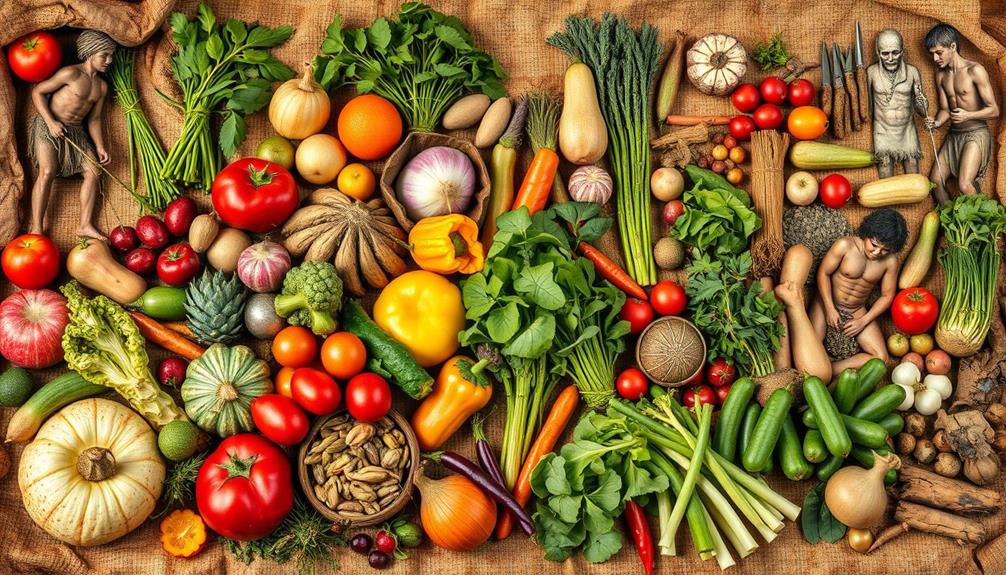
Dietary practices throughout history reflect a fascinating interplay between culture, health, and spirituality. You'll find that raw foodism has roots in asceticism, where hermits and monks consumed uncooked foods to enhance their spiritual discipline. By the late 19th and early 20th centuries, figures like Eugene and Mrs. Christian began advocating for uncooked diets aimed at health restoration, as highlighted in their influential book, "Uncooked Foods and How to Use Them."
Maximilian Oskar Bircher-Benner played a pivotal role in modern raw food practices, establishing a sanatorium that celebrated raw fruits and vegetables, linking them to nutrition and disease prevention. His work in the 1920s notably shifted dietary norms, challenging traditional cooking methods.
Here's a quick overview of key historical figures and concepts in raw foodism:
| Historical Figure | Contribution | Key Concept |
|---|---|---|
| Eugene and Mrs. Christian | Promoted uncooked diets for health restoration | Influence of uncooked foods |
| Maximilian Oskar Bircher-Benner | Advocate for raw foods in health care | Nutrition linked to disease prevention |
| Hermits and Monks | Consumed uncooked foods for spirituality | Asceticism and dietary practices |
Health Benefits of Raw Foods

When you switch to a raw food diet, you're packing your meals with nutrient-dense fruits and vegetables that can boost your overall health.
Incorporating nutrient-rich ingredients like chia seeds can further enhance the benefits due to their high omega-3 fatty acids and fiber content.
This approach not only enhances your digestion but also supports gut health thanks to natural enzymes and fiber.
Nutrient Density Advantages
The raw food diet offers impressive nutrient density advantages that can substantially enhance your health. By focusing on fresh fruits and vegetables, you'll consume an abundance of essential vitamins, minerals, and antioxidants that your body craves.
Additionally, incorporating raw foods can complement practices like essential oils for skin conditions, further promoting overall wellness. Raw foods retain more natural enzymes and nutrients, which can be lost through cooking, making them a powerful choice for ideal health.
Here are some key benefits of nutrient density in the raw food diet:
- High in Vitamins: Fresh fruits and vegetables provide a wealth of crucial nutrients that support your overall well-being.
- Rich in Antioxidants: These foods help combat oxidative stress, potentially lowering your risk of chronic diseases.
- Promotes Weight Loss: With lower calorie intake and higher nutrient density, you may find it easier to maintain a healthy weight.
- Supports Chronic Disease Prevention: A diet rich in raw foods is linked to a reduced risk of heart disease, diabetes, and certain cancers.
Enhanced Digestive Health
Eating raw foods can greatly enhance your digestive health, thanks to their rich content of natural enzymes and fiber. The raw food diet, primarily consisting of uncooked fruits and vegetables, offers numerous benefits for digestion. Natural enzymes present in these foods help break down nutrients more efficiently, improving absorption.
Increased fiber intake from raw foods promotes regular bowel movements and helps prevent constipation, considerably contributing to your overall digestive health. Furthermore, a diverse intake of raw fruits and vegetables may enhance gut microbiota diversity, resulting in better digestive function and a stronger immune system.
Research shows that a high intake of raw vegetables is linked to a lower risk of digestive disorders, such as irritable bowel syndrome. Additionally, the hydration provided by fresh produce supports digestive processes and maintains ideal gut function.
| Benefits of Raw Foods | Description |
|---|---|
| Natural Enzymes | Aid in digestion and nutrient absorption |
| Fiber Intake | Promotes healthy bowel movements and prevents constipation |
| Gut Microbiota | Enhances diversity for improved digestive function |
| Protection Against Disorders | Reduces risk of conditions like irritable bowel syndrome |
| Hydration | Supports digestive processes and maintains gut function |
Risks and Nutritional Concerns
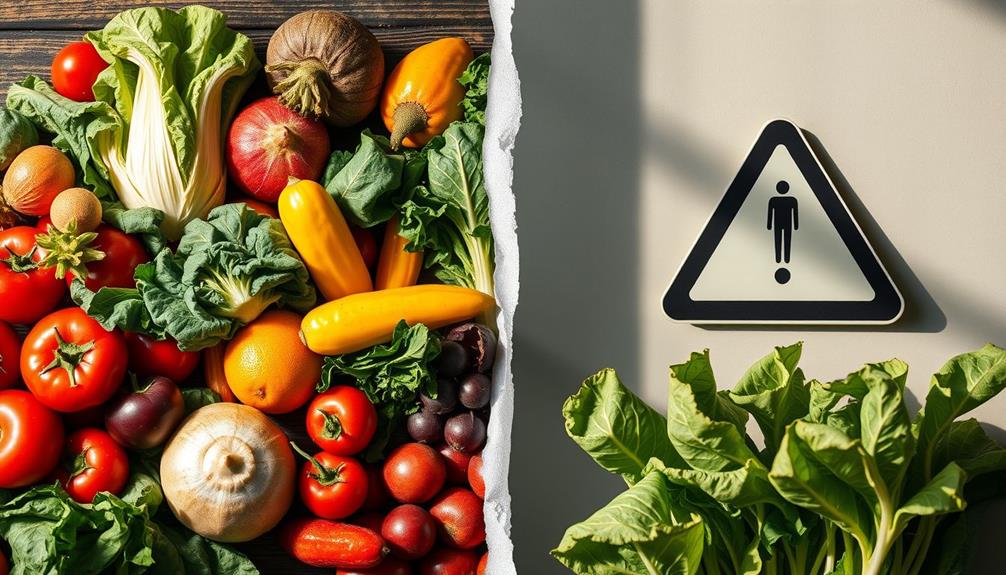
Maneuvering the raw food diet can expose you to several risks and nutritional concerns that are important to contemplate. While many people are drawn to the raw food diet for its health benefits, you should be aware of potential drawbacks.
Long-term adherence can lead to significant nutritional deficiencies, particularly in:
- Protein: Essential for muscle and tissue repair.
- Vitamin B12: Vital for nerve function and blood cell production.
- Calcium: Important for bone health.
- Caloric intake: Insufficient calories can lead to low body mass and related health issues.
Understanding the importance of a personal budget can help you manage food expenses while guaranteeing a balanced diet.
Additionally, the raw food diet carries health risks associated with foodborne illnesses. The consumption of raw dairy and meats can increase exposure to pathogens like Listeria and E. coli.
It's also worth noting that a strict raw vegan diet may put women at risk for amenorrhea due to inadequate caloric and nutrient intake. The British Dietetic Association classifies raw foodism as a fad diet, stressing the potential for nutritional imbalances.
If you're considering this lifestyle, make sure to weigh these risks against the benefits and consult with a healthcare professional to confirm you're meeting your nutritional needs.
Cultural Perspectives on Raw Foodism

Cultural Perspectives on Raw Foodism
Throughout history, raw foodism has sparked diverse cultural perspectives that challenge traditional culinary practices. Many communities view raw foodism as a way to reconnect with nature, emphasizing the health benefits of unprocessed foods. Indigenous populations often incorporated raw foods into their diets, believing these fresh ingredients were crucial for vitality and well-being. This historical dietary practice laid a foundation for modern interpretations of raw foodism.
Additionally, the benefits of raw food include enhanced nutrient absorption and increased energy levels, further reinforcing its appeal across different cultures.
Cultural beliefs play a significant role in how people accept or reject raw diets. For some, embracing raw foodism is a form of lifestyle enhancement, promoting a healthier way of living. Prominent figures like Eugene Christian and Maximilian Bircher-Benner have shaped public perception, advocating for the philosophy of consuming raw foods for their supposed health benefits. Their influence helped elevate raw foodism beyond niche diets to mainstream awareness.
As raw foodism continues to evolve, it remains intertwined with cultural attitudes towards food preparation and health. By understanding these cultural perspectives, you can appreciate the depth of raw foodism and its ongoing impact on dietary choices around the world.
Modern Trends and Interpretations

In recent years, the raw food diet has surged in popularity, with many people turning to it as a way to enhance their health and well-being. Influenced by key figures and modern trends, this movement has evolved to include various interpretations and practices.
You might find yourself intrigued by:
- Raw veganism: A plant-based approach that eliminates all animal products.
- Detoxification: Many followers believe raw foods help cleanse the body, contributing to emotional resilience and overall well-being as highlighted in the power of imagination.
- Holistic wellness: The diet often incorporates a lifestyle focusing on mental and emotional health.
- Sustainability: There's a growing emphasis on organic farming practices and environmental consciousness.
The modern raw food diet aligns with ideal health goals, promoting ethical eating and better food choices.
Social media and celebrity endorsements have played significant roles in popularizing raw food lifestyles, leading to an increase in raw food restaurants and products.
You might notice how these trends adapt to current health philosophies, reflecting a broader awareness of the impact of food choices on both personal health and the planet.
As you explore this lifestyle, consider how it resonates with your values of sustainability and ethical consumption.
Frequently Asked Questions
What Is the Full Explanation of the Raw Food Diet?
The raw food diet focuses on unprocessed, uncooked foods to maximize nutrient intake. You'll consume fruits, vegetables, nuts, and seeds, believing it boosts energy and digestion, while being mindful of potential nutrient deficiencies.
What Is the Truth About the Raw Food Diet?
Over 60% of raw food diet followers report improved energy levels. You'll find some benefits, like better digestion, but be cautious—nutrient deficiencies and foodborne illness risks can outweigh those perks if you're not careful.
What Is the Science Behind the Raw Meat Diet?
The science behind the raw meat diet emphasizes higher nutrient levels and enzyme preservation. However, it exposes you to harmful pathogens and nutrient deficiencies, raising significant health concerns that demand careful consideration before you decide to try it.
What Is the History of Raw Meat?
You'll find that raw meat consumption dates back to prehistoric times, with early humans relying on it for survival. Ancient cultures embraced it, and health advocates later promoted it for its supposed benefits, despite safety concerns.
Conclusion
In a world where kale reigns supreme and avocado toast is practically a food group, the raw food diet stands as the ultimate health guru, preaching the virtues of unprocessed goodness. By embracing this vibrant lifestyle, you're not just nibbling on veggies; you're commencing a crunchy crusade for wellness! Sure, there are some risks, but who wouldn't trade a few cooked meals for a fresh, radiant glow? Immerse yourself—your taste buds and body will thank you!

